
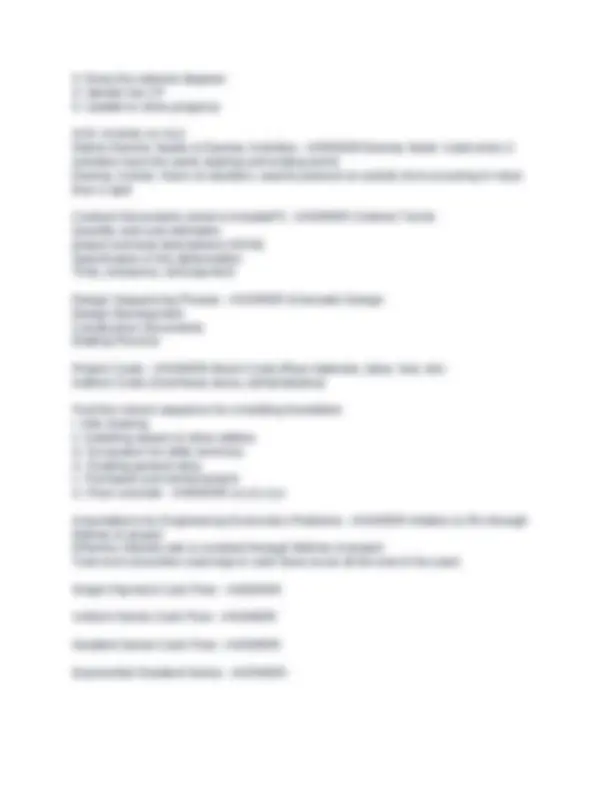
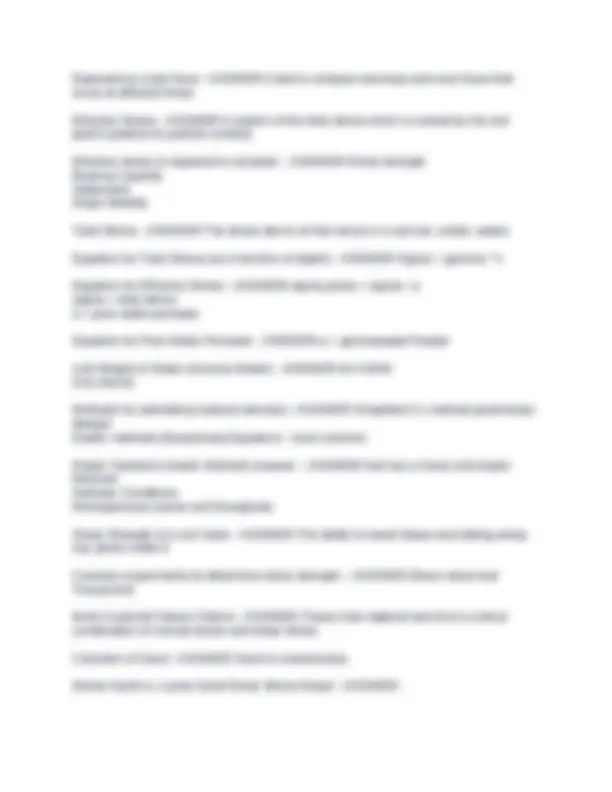
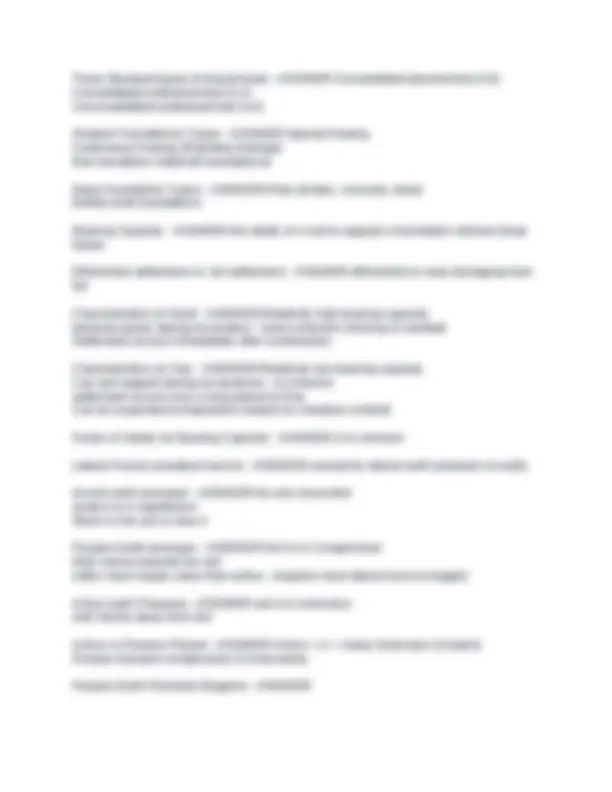
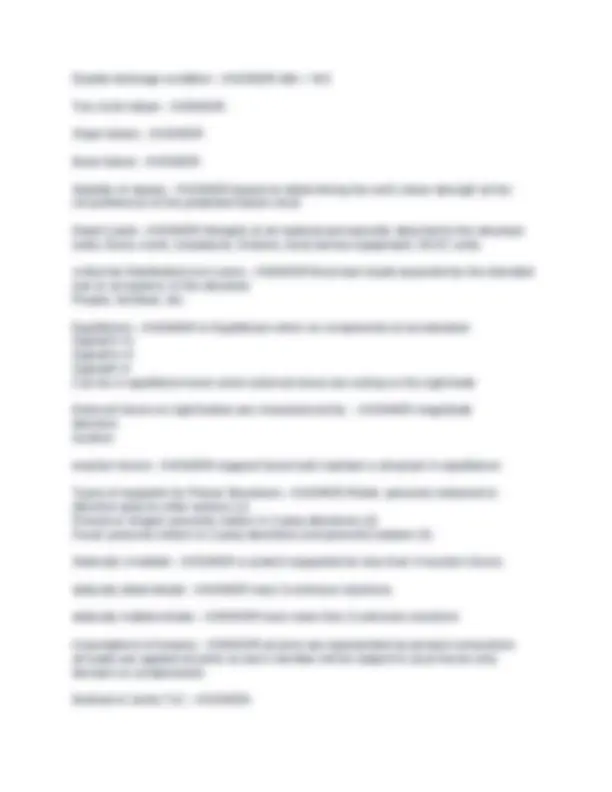
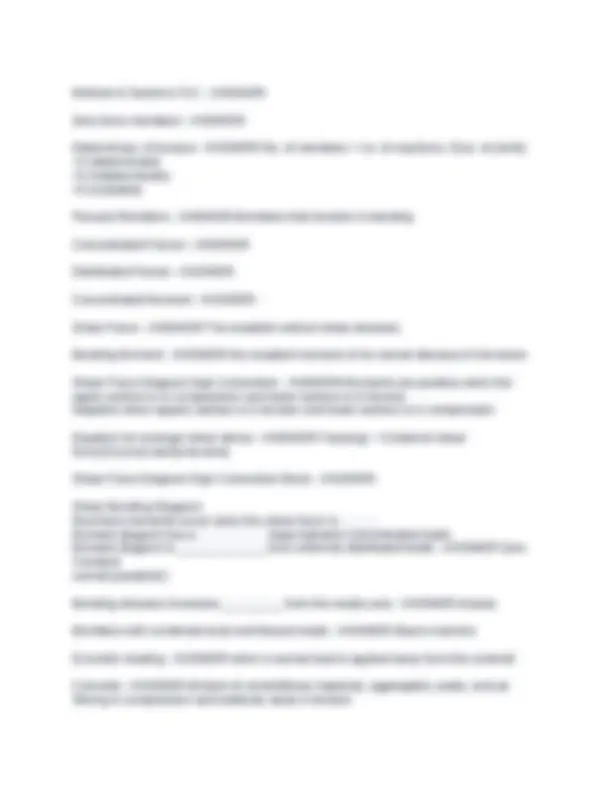
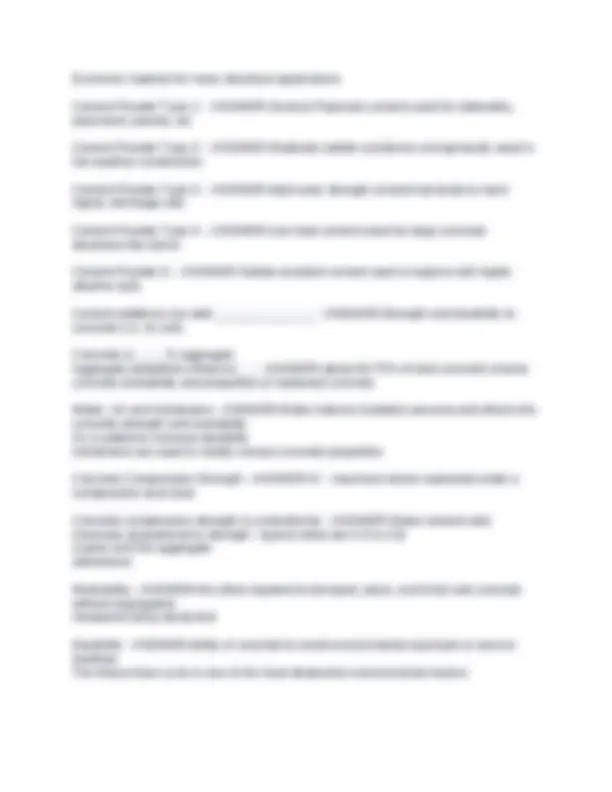
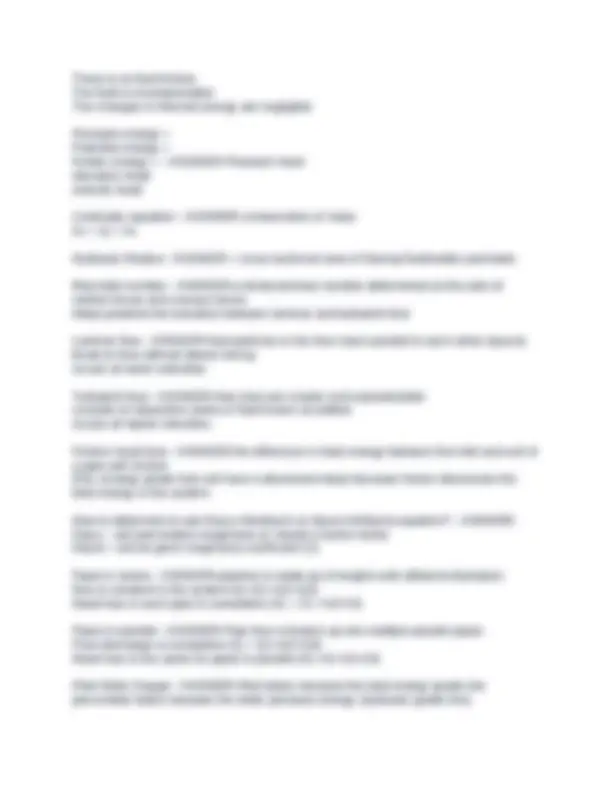
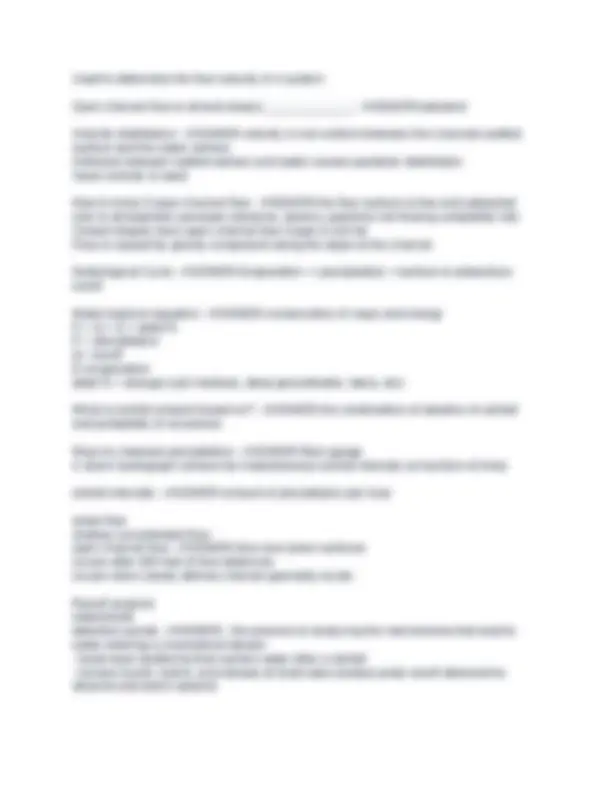
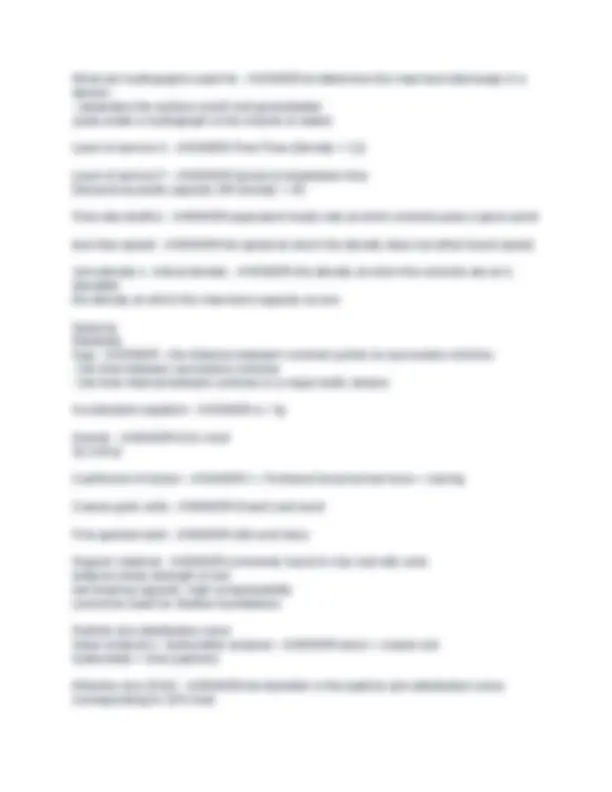
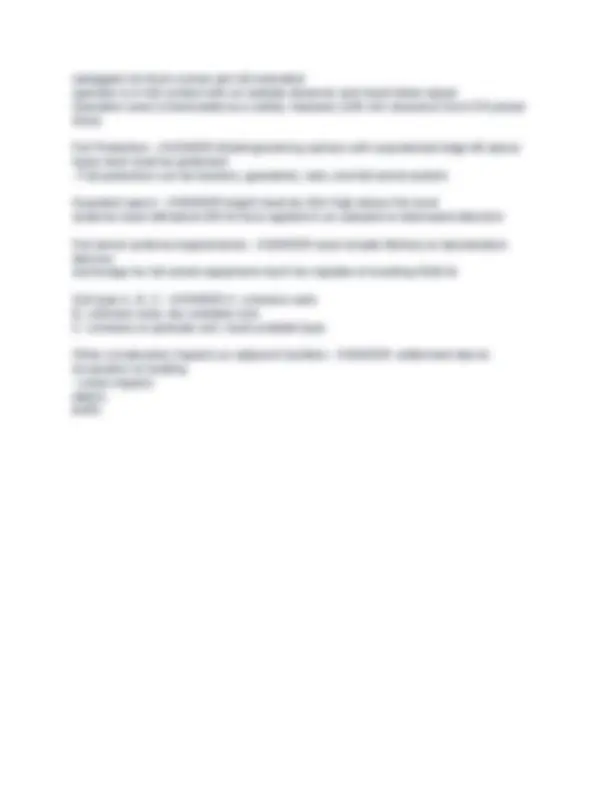


Study with the several resources on Docsity

Earn points by helping other students or get them with a premium plan


Prepare for your exams
Study with the several resources on Docsity

Earn points to download
Earn points by helping other students or get them with a premium plan
Community
Ask the community for help and clear up your study doubts
Discover the best universities in your country according to Docsity users
Free resources
Download our free guides on studying techniques, anxiety management strategies, and thesis advice from Docsity tutors
PE Exam – Construction with Accurate Solutions
Typology: Exams
1 / 18

This page cannot be seen from the preview
Don't miss anything!











Types of Loads - ANSWER-Dead, Live, Construction, Environmental, and Lateral Earth Pressure Available Design Methods for Construction Loads - ANSWER-Allowable Stress Design (ASD) Load and Resistance Factor Design (LRFD) Building Type & Construction Method - ANSWER-Residential: Light wood stick framing Commercial: Wood, steel, or masonry High-rise and other commercial: heavy steel framing or reinforced concrete Long-Span Bridges: steel cables Wood Framing - ANSWER-Most common way to build houses in NA Simplified Building Procedure for Wood House - ANSWER-1. Place concrete foundation
Advantage of Precast Concrete - ANSWER-Higher quality fabrication from casting off- site Can accelerate construction schedules A two-story multi-family residential structure is being construction in a high seismic area. Which construction type is most likely to be used? - ANSWER-Wood Framing (2-story, low rise residential) "High-seismic" is a distractor Temporary Structures - ANSWER-May be removed at end of construction (usually) May be incorporated into the finished structure Concrete formwork is a common example of temporary structure Design Considerations of Concrete formwork - ANSWER-Dead Load: weight of fresh concrete plus form self weight Live Load: 50-75 psf depending on equipment used (to pour concrete) Lateral pressure exerted by fresh concrete Typical formwork material - ANSWER-3/4" plywood that is coated on one side Types of concrete formwork - ANSWER-Slab Formwork Beam Formwork Column/Wall Formwork (look at photos) Equation for Lateral Pressures of Concrete - ANSWER-ACI 347R-14 Table 4.2.2.1a(a) Project Management Process Groups - ANSWER-Initiation -> Planning -> executing -> Controlling and monitoring (loop back to planning) -> closing Ex. of loop (Value Engineering) Gantt Chart - ANSWER-Small to mid-size projects Forecast & manage resources (labor, equipment, budgets, etc) Disadvantage: doesn't show all the links/sequencing Critical Path Method (CPM) - ANSWER-Project modeling technique that identifies the most critical activities on a schedule Helps monitor the assets, expenses, and advancement of the project Activity on Node (AON) is most common PERT - ANSWER-Program Evaluation Review Technique (also known as CPM) Float Time (slack time) - ANSWER-Amount of time that an activities can be delayed without affecting the overall schedule (applies to activities not on CP) Applying the CPM (steps) - ANSWER-1. Specify each activity
Equivalence (cash flow) - ANSWER-Used to compare earnings and cash flows that occur at different times Effective Stress - ANSWER-A portion of the total stress which is carried by the soil grains (particle to particle contact) Effective stress is required to calculate: - ANSWER-Shear strength Bearing Capacity Settlement Slope Stability Total Stress - ANSWER-The stress due to all the forces in a soil (air, solids, water) Equation for Total Stress (as a function of depth) - ANSWER-Sigma = gamma * h Equation for Effective Stress - ANSWER-sigma prime = sigma - u sigma = total stress u = pore water pressure Equation for Pore Water Pressure - ANSWER-u = gammawater*hwater Unit Weight of Water (Gamma Water) - ANSWER-62.4 lb/ft 9.81 kN/m Methods for estimating induced stresses - ANSWER-Simplified 2:1 method (preliminary design) Elastic methods (Boussinesq Equation) - most common Elastic Solutions (elastic Method) assume: - ANSWER-Soil has a linear and elastic behavior Isotropic Conditions Homogeneous (same soil throughout) Shear Strength of a soil mass - ANSWER-The ability to resist failure and sliding along any plane inside it Common experiments to determine shear strength: - ANSWER-Direct shear test Triaxial test Mohr-Coulomb Failure Criteria - ANSWER-Theory that material fails from a critical combination of normal stress and shear stress Cohesion of Sand - ANSWER-Sand is cohesionless Dense Sand vs. Loose Sand Shear Stress Graph - ANSWER-
Three Standard types of triaxial tests - ANSWER-Consolidated-drained test (CD) Consolidated-undrained test (CU) Unconsolidated-undrained test (UU) Shallow Foundations Types - ANSWER-Spread Footing Continuous Footing (Wall/strip footings) Mat foundation (slab/raft foundations) Deep Foundation Types - ANSWER-Piles (timber, concrete, steel) Drilled shaft foundations Bearing Capacity - ANSWER-the ability of a soil to support a foundation without shear failure Differential settlement vs. full settlement - ANSWER-differential is more damaging than full Characteristics of Sand - ANSWER-Relativity high bearing capacity behaves poorly during excavation - lacks cohesion (shoring is needed) Settlement occurs immediately after construction Characteristics of Clay - ANSWER-Relatively low bearing capacity Can self-support during excavations - is cohesive settlement occurs over a long period of time Can be expansive/compressive (based on moisture content) Factor of Safety for Bearing Capacity - ANSWER-3 is common Lateral Forces (resultant forces) - ANSWER-caused by lateral earth pressure on walls At-rest earth pressure - ANSWER-No soil movement system is in equilibrium Strain in the soil is near 0 Passive Earth pressure - ANSWER-Soil is in Compression Wall moves towards the soil (often much larger value than active - requires more lateral force to trigger) Active earth Pressure - ANSWER-soil is in extension wall moves away from soil Active vs Passive Phrase - ANSWER-Active = A = Away=Extension (Vowels) Passive=toward=compression (Consonants) Passive Earth Pressure Diagram - ANSWER-
Define surcharge - ANSWER-An additional load applied on the restrained soil Can be uniform, point, or line loads Settlement - ANSWER-Soil deformation due to vertical stress causes: deformation in soil particles, relocation of soil particle and explusion of water or air from void spaces Types of Settlement - ANSWER-Elastic (or immediate) settlement Primary Consolidation Settlement Secondary Consolidation Settlement Elastic Settlement - ANSWER-Occurs rapidly, typically during construction main cause of settlement for coarse-grained soils Based on theory of elasticity Primary consolidation settlement - ANSWER-Resulting from volume change in saturated soils due to explusion of water Process may require months to years Main cause for fine-grained soils Secondary Consolidation Settlement - ANSWER-Long-term rain distortion Occurs after Primary & may require years Typically observed in saturated cohesive soils and organic soils Total consolidation settlement - ANSWER-Elastic + Primary + secondary Consolidation curves - ANSWER-developed to study the chain in void ratio of a soil sample with pressure as Stress increases, void ratio decreases Consolidation Curve - ANSWER- 3 cases of primary consolidation - ANSWER-case 1: soil is already normally consolidated case 2: soil remains overconsolidation case 3: soil was overconsolidation but becomes normally consolidated Case 1 curve - ANSWER- Case 2 curve - ANSWER- Time rate of settlement - ANSWER-based on the principles of conservation of mass Rate of outflow of water - rate of inflow of water = rate of volume change Single drainage condition - ANSWER-Hdr = H
Double drainage condition - ANSWER-Hdr = H/ Toe circle failure - ANSWER- Slope failure - ANSWER- Base failure - ANSWER- Stability of slopes - ANSWER-based on determining the soil's shear strength at the circumference of the predicted failure circle Dead Loads - ANSWER-Weights of all material permanently attached to the structure walls, floors, roofs, insulations, finishes, fixed service equipment, HVAC units Uniformly Distributed Live Loves - ANSWER-Maximum loads expected by the intended use or occupancy of the structure People, furniture, etc. Equilibrium - ANSWER-In Equilibrium when no components of acceleration SigmaFx= SigmaFy= SigmaM= Can be in equilibrium even when external forces are acting on the rigid body External forces on rigid bodies are characterized by: - ANSWER-magnitude direction location reaction forces - ANSWER-support forces taht maintain a structure in equilibrium Types of supports for Planar Structures - ANSWER-Roller: prevents motioned in direction perp to roller surface (1) Pinned or hinged: prevents motion in 2 perp directions (2) Fixed: prevents motion in 2 perp directions and prevents rotation (3) Statically Unstable - ANSWER-a system supported by less than 3 reaction forces statically determinate - ANSWER-have 3 unknown reactions statically indeterminate - ANSWER-have more than 3 unknown reactions Assumptions of trusses - ANSWER-all joins are represented as pinned connections all loads are applied at joints so each member will be subject to axial forces only (tension or compression) Method of Joints TvC - ANSWER-
Economic material for many structural applications Cement Powder Type 1: - ANSWER-General Purposes cement used for sidewalks, pavement culverts, etc Cement Powder Type 2: - ANSWER-Moderate sulfate resistance and generally used in hot weather construction Cement Powder Type 3: - ANSWER-High-early strength cement but tends to have higher shrinkage rate Cement Powder Type 4: - ANSWER-Low heat cement used for large concrete structures like dams Cement Powder 5: - ANSWER-Sulfate resistant cement used in regions with highly alkaline soils Cement additives can add _______________ - ANSWER-Strength and durability to concrete (i.e. fly ash) Concrete is ____ % aggregate Aggregate properties influence___ - ANSWER-about 60-70% of total concrete volume concrete workability and properties of hardened concrete Water, Air and Admixtures - ANSWER-Water induces hydration process and affects the concrete strength and workability Air is added to increase durability Admixtures are used to modify various concrete properties Concrete Compressive Strength - ANSWER-fc' - maximum stress sustained under a compressive axial load Concrete compressive strength is controlled by - ANSWER-Water-cement ratio (inversely proportional to strength - typical ratios are 0.4 to 0.6) coarse and fine aggregate admixtures Workability - ANSWER-the effort required to transport, place, and finish wet concrete without segregation measured using slump test Durability - ANSWER-ability of concrete to resist environmental exposure or service loadings The freeze-thaw cycle is one of the most destructive environmental factors
Concrete Compressive Strength Test - ANSWER-Mold cylinder, cured for a specific amount of time at a specific temperature, specimen is axially loaded at a specific rate until failure Splitting tensile strength test (concrete) - ANSWER-Split cylinder test procedure cast (or drilled) cylinder is placed on its side and loaded until failure Concrete strength characteristics - ANSWER-Concrete does not have a yield strength, it behaves in a brittle manner and just cracks Not strong in tension Reinforcing Steel - ANSWER-used to resist tensile forces in concrete structures steel performs well in tension b/c of the elastic properties Common types of hot rolled structural steel used for building construction - ANSWER- Carbon High strength low alloy Quenched and tempered alloy Steel properties dependent on the type of steel - ANSWER-Yield stress tensile strength Steel properties independent on the type of steel - ANSWER-modulus of elasticity density geometric properties Stress-strain curve for structural steel - ANSWER- W L HSS PL - ANSWER-Structural steel shapes Wide flange Angle Hollow structural section Plate Assumptions for reinforced concrete beam design - ANSWER-Concrete is assumed to resist compression only Tension is resisted by the steel reinforcement shear is resisted by stirrup bars positioned vertically ASD service level loads are used for the design - ANSWER-Allowable strength design Factor of safety (omega) is applied to the nominal strength is based on load type (shear, axial, moment)
There is no fluid friction The fluid is incompressible The changes in thermal energy are negligible Pressure energy = Potential energy = Kinetic energy = - ANSWER-Pressure head elevation head velocity head Continuity equation - ANSWER-conservation of mass Av = Q = Av Hydraulic Radius - ANSWER-= cross sectional area of flowing fluid/wetter perimeter Reynolds number - ANSWER-a dimensionless number determined as the ratio of inertial forces and viscous forces Helps predicts the transition between laminar and turbulent flow Laminar flow - ANSWER-fluid particles in the flow move parallel to each other (layers) tends to flow without lateral mixing occurs at lower velocities Turbulent flow - ANSWER-flow lines are chaotic and unpredictable consists of interactive swirls of fluid known as eddies occurs at higher velocities Friction head loss - ANSWER-the difference in total energy between the inlet and exit of a pipe with friction EGL (energy grade line) will have a downward slope because friction decreases the total energy in the system How to determine to use Darcy-Weisbach or Hazen-Williams equation? - ANSWER- Darcy - will eed relative roughness or moody's friction factor Hazen - will be given roughness coefficient (C) Pipes in series - ANSWER-pipeline is made up of lengths with different diameters flow is constant in the system (Q=Q1=Q2=Q3) Head loss in each pipe is cumulative (hL = h1 +h2+h3) Pipes in parallel - ANSWER-Pipe flow is broken up into multiple parallel pipes Flow discharge is cumulative (Q = Q1+Q2+Q3) Head loss is the same for pipes in parallel (hL=h1=h2=h3) Pitot-Static Gauge - ANSWER-Pitot tubes measure the total energy grade line piezometer tubes measure the static pressure energy (hydraulic grade line)
Used to determine the flow velocity of a system Open channel flow is almost always _____________ - ANSWER-turbulent Velocity distribution - ANSWER-velocity is non-uniform between the channels wetted surface and the water surface Adhesion between wetted surface and water causes parabolic distribution mean velocity is used How to know if open channel flow - ANSWER-the flow surface is free and subjected only to atmospheric pressure (streams, sewers, pipelines not flowing completely full) Closed shapes have open channel flow if pipe is not full Flow is caused by gravity component along the slope of the channel Hydrological Cycle - ANSWER-Evaporation -> precipitation ->surface & subsurface runoff Water balance equation - ANSWER-conservation of mass and energy P = Q + E + deltaS P = precipitation Q= runoff E=evaporation deltaS = storage (soil moisture, deep groundwater, lakes, etc) What is rainfall amount based on? - ANSWER-the combination of duration of rainfall and probability of occurence Ways to measure precipitation - ANSWER-Rain gauge A storm hyetograph (shows the instantaneous rainfall intensity as function of time) rainfall intensity - ANSWER-amount of precipitation per hour sheet flow shallow concentrated flow open channel flow - ANSWER-flow over plane surfaces occurs after 300 feet of flow distances occurs when clearly defines channel geometry exists Runoff analysis watersheds detention ponds - ANSWER-- the process of analyzing the mechanisms that lead to water entering a channelized stream
Atterberg Limits 4 basic states of soil - ANSWER-Used to describe the consistency of fine-grained soils Solid, semisolid, plastic, liquid Plasticity Index High PI, medium PI, Low PI - ANSWER-High = clayey soils medium = silty low = sandy AASHTO A-1, A-2, A- A-4, A-5, A-6, A-7 - ANSWER-A-1, - A-3: granular materials A-4 - A-7: silt-clay A-1 is best subgrade rating A-7 is worst USCS is based on.... - ANSWER-Based on grain size (sieve analysis - coarse-grained) Unit weight - ANSWER-gamma = W/V Density - ANSWER-rho = Mass/volume relative density - ANSWER-used to indicate the denseness or looseness of granular soil permeability - ANSWER-exists in soils when water is transferred through particle voids. water flows from point of high energy to low energy Hydraulic conductivity (k) - ANSWER-the soil parameter for the rate of seepage Constant-head test vs. falling-head test - ANSWER-constant-head: coarse, permeable soils (gravels & sands) falling-head: finer, less permeable soils (clays & silty soils) advantages of soil compaction - ANSWER-- increase strength and stability
smooth-wheel rollers pneumatic rubber-tired rollers sheepsfoot rollers vibratory rollers - ANSWER-- suited for finishing operations of fills for sandy & clayey soils